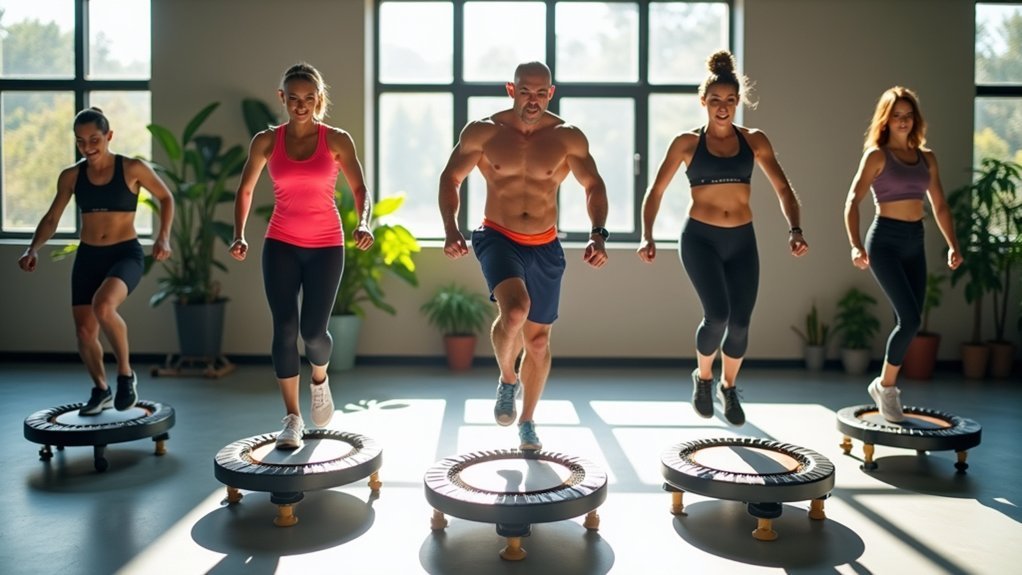The 5 best lymphatic exercises for defined muscles include rebounding on a mini-trampoline, high-knee bounces, twist jumps, rebound sprints, and gentle recovery bouncing. These movements activate your lymphatic system, flush out toxins, and reduce inflammation that obscures muscle definition. Just 2-3 minutes of rebounding can cleanse your entire lymphatic system, enhancing recovery and revealing muscle tone. Discover how these simple exercises can transform your physique beyond traditional strength training alone.
The Science Behind Lymphatic Drainage and Muscle Definition

While many fitness enthusiasts focus solely on resistance training and cardio for muscle definition, the lymphatic system plays an equally essential but often overlooked role in achieving that sculpted look.
Your lymphatic vessels remove waste and excess fluids from your muscles, preventing puffiness that can obscure definition. Unlike your circulatory system, your lymphatic system lacks a central pump, relying instead on muscle contractions and tissue movement to push fluid through vessels and nodes.
While blood has the heart, lymph needs your movement to flow, clearing the fluid that hides your hard-earned definition.
When you breathe deeply or contract muscles, you create pressure gradients that enhance lymphatic flow. This process helps clear toxins that would otherwise hinder muscle performance and definition. Incorporating deep diaphragmatic breathing during your fitness routine can significantly enhance lymphatic circulation.
The science is clear: optimal lymphatic function through strategic movement improves circulation, reduces inflammation, and ultimately reveals more defined muscles.
How Rebounding Activates Your Body’s Natural Detox System
When you step onto a rebounder, you’re activating one of the most powerful natural detoxification methods available. The gentle bouncing creates a pumping effect that moves lymphatic fluid through your body, effectively flushing out toxins and metabolic waste. Rebounding provides complete cellular exercise for efficient elimination of cellular waste products throughout your entire body.
Just two minutes of rebounding can cleanse your entire lymphatic system. During this exercise, the quick gravity changes cause lymphatic vessels to expand, enhancing circulation and immune function by increasing white blood cell production.
| Rebounding Duration | Lymphatic Effect | Muscle Benefit |
|---|---|---|
| 2 minutes | Full system flush | Improved circulation |
| 10 minutes | Increased white blood cells | Enhanced definition |
| 20 minutes | Sustained detoxification | Balanced development |
| 30+ minutes | Maximum immune boost | Optimized recovery |
You’ll experience less inflammation, faster recovery, and better muscle definition as your body’s natural detox system operates more efficiently.
Mini-Trampoline Basics: Setting Up for Maximum Lymphatic Flow

Your ideal bounce technique starts with selecting a trampoline height that supports gentle, controlled movements rather than high jumps.
You’ll want to adjust your mat tension to achieve the perfect balance between firmness and flexibility, allowing for effective lymph stimulation without jarring your joints.
Incorporating short lymph-activating intervals of 2-3 minutes throughout your routine will maximize fluid circulation while preventing fatigue and maintaining proper form.
The rebounder workout is suitable for all fitness levels, from complete beginners to more active individuals looking to enhance their exercise routine.
Optimal Bounce Technique
Mastering the ideal bounce technique begins with proper positioning on your mini-trampoline to create effective lymphatic flow. Stand with feet hip-width apart, spine aligned, and core engaged.
Focus on vertical movement while keeping bounces gentle—just 2-4 inches off the mat. This low-impact approach maximizes lymphatic pumping without stressing joints. Breathe rhythmically: inhale as you rise, exhale as you descend.
| Technique Element | Correct Form | Benefit |
|---|---|---|
| Foot Position | Hip-width apart | Stability |
| Bounce Height | 2-4 inches | Joint protection |
| Landing Mechanics | Absorb with foot muscles | Reduced strain |
| Arm Movement | Natural swing or overhead | Upper lymph activation |
For enhanced lymphatic stimulation, incorporate directional variations with subtle side-to-side leans and gentle torso rotations while airborne. Always begin with a 2-minute marching warm-up. This low-impact exercise is particularly beneficial for individuals with arthritis as it’s gentle on the joints while still providing effective lymphatic stimulation.
Trampoline Height Selection
Selecting the ideal height for your mini-trampoline directly influences lymphatic circulation and muscle definition results.
Standard models at 8-10 inches provide peak G-force generation while preserving joint safety, but consider your specific needs.
If you’re prioritizing lymphatic stimulation, choose trampolines with firmer surfaces at slightly higher heights to enhance upward propulsion and lymph valve activation.
For beginners or those with joint concerns, lower-profile designs (6-8 inches) reduce impact while maintaining adequate gravitational pull.
Look for adjustable legs offering 1-3 inch variations to customize the experience based on your weight and desired rebound responsiveness.
Remember that exceeding the weight capacity (typically 250-300 lbs) will compress springs and reduce bounce amplitude, compromising the lymphatic pumping action essential for muscle definition.
Recent research indicates that consistent jumping on mini-trampolines can increase lymph flow by up to 15 times compared to resting states, making it an excellent choice for muscle definition routines.
Lymph-Activating Intervals
While setting up your mini-trampoline environment, prioritize proper technique to maximize lymphatic flow benefits. Stand with feet hip-width apart and knees slightly bent to protect joints while engaging core muscles. This position enhances the G-force activation that stimulates lymphatic valves. The rebounding motion triggers white blood cells to triple their count during each session, providing an immediate immune response boost.
| Duration | Movement Type | Benefit |
|---|---|---|
| 2-3 min | Gentle bouncing | Primes lymphatic valves |
| 30 sec | Light jogging | Stimulates immune circulation |
| 1-2 min | Heel lifts | Activates calf pump mechanism |
Choose a rebounder with sturdy handles and bungee-based tension for reduced impact. Aim for 10-minute sessions 3-5 times weekly, focusing on rhythmic movements that create the valve-pumping effect. Remember that consistent short sessions (5-7 minutes daily) deliver better results than occasional longer workouts for maintaining peak lymph flow.
Basic Bounce Technique for Full-Body Lymphatic Stimulation

Bounce your way to better lymphatic health with the Basic Bounce Technique, a foundational practice that stimulates your entire lymphatic system through gentle, rhythmic movements.
This low-impact rebounding approach engages your entire body while promoting balance and coordination. These movements are similar to the deep breathing techniques that stimulate lymph nodes and enhance overall lymphatic circulation.
Start with just two minutes of gentle bouncing to effectively activate your lymphatic system. You’ll be amazed how quickly your body responds—studies show rebounding can triple your white blood cell count, dramatically boosting immunity.
- Begin with side-to-side bounces to circulate lymph throughout your core.
- Add arm movements like gentle curls or waves to enhance upper body flow.
- Incorporate forward and backward steps to target leg lymphatics.
As you progress, gradually increase both duration and intensity while maintaining proper alignment.
High-Knee Rebounding for Core and Thigh Definition
High-knee rebounding transforms your standard lymphatic workout into a powerful muscle-defining exercise, specifically targeting your core and thighs while maximizing lymphatic flow.
Elevate your lymphatic health with every bounce as high-knees sculpt your physique and amplify detoxification.
Stand with feet hip-width apart, engage your core, and begin lifting your knees to hip height or higher. Coordinate your arm swing naturally as you rebound, which activates upper body muscles while enhancing rhythm. Breathe rhythmically with each movement to maintain proper oxygen flow.
This technique intensifies quadriceps and hip flexor engagement while your lower abs stabilize against gravitational forces. The vertical G-forces stimulate lymph drainage in your inguinal and axillary regions, boosting detoxification and metabolic rate. The equal force distribution throughout the body helps strengthen muscles without putting stress on any particular joint.
Begin with static marches before progressing to faster tempos. For best results, perform barefoot sessions of 10-15 minutes on a properly tensioned rebounder.
Twist Jumps for Oblique Strengthening and Waist Sculpting
Twist jumps represent a powerful addition to your lymphatic rebounding routine, specifically targeting your oblique muscles while promoting waist definition.
This dynamic exercise combines cardio benefits with strength training, making it perfect for home workouts or HIIT circuits. Remember to maintain balance while performing each lateral hop from right to left during your twist jumps.
To maximize your results, focus on these key techniques:
- Proper Form – Sit with knees bent, lift legs, and twist your torso side to side while maintaining a straight back.
- Progressive Challenge – Begin with basic movements, then add dumbbells or medicine balls as your strength improves.
- Breathing Control – Maintain steady breathing throughout to enhance oxygenation and support lymphatic circulation.
You’ll notice improved flexibility and core stability as you incorporate twist jumps regularly, contributing to both a sculpted waistline and enhanced lymphatic flow.
Rebound Sprints for Accelerated Lymphatic Circulation
Rebound sprints represent the cornerstone of accelerated lymphatic circulation, engaging your entire cardiovascular system while simultaneously activating the one-way valves that propel lymph through your body.
Just two minutes of bouncing flushes your entire lymphatic system, with vigorous rebounding increasing flow up to 30 times normal rates.
For maximum detoxification, perform 10-30 second sprints at 50-70% effort with 30-60 second rest intervals.
This acceleration-deceleration pattern creates the perfect mechanical pump for lymph fluid, preventing stagnation while boosting white blood cell circulation.
Aim for three 3-minute sessions daily to optimize lymphatic stimulation without fatigue. The lymphatic system functions as your body’s vacuum cleaner, removing waste and supporting immune function.
You’ll notice improved muscle definition as capillary density increases, enhanced energy from mitochondrial production, and reduced inflammation markers with consistent 3-5 weekly sessions.
Recovery Bouncing: Gentle Movements for Post-Workout Detox
You’ll accelerate muscle recovery by incorporating gentle rebounding movements that create a cellular vacuum-like effect to clear metabolic waste.
This low-impact trampoline technique requires only minimal movement—as little as half-inch heel lifts—to effectively flush toxins through your lymphatic system.
After intense workouts, just 2-3 minutes of recovery bouncing can greatly reduce inflammation while enhancing nutrient delivery to fatigued muscles. Keeping your knees slightly bent with feet hip-width apart helps maintain proper form during the lymphatic pat down sequence for maximum detoxification benefits.
Rebound for Muscle Relief
Bounce your way to faster recovery with gentle rebounding movements that revolutionize post-workout muscle relief.
This zero-impact activity enhances lymphatic flow through G-force stimulation while preventing exercise-induced edema by discouraging fluid pooling in your extremities.
Your muscles recover faster as rebounding accelerates lactic acid clearance and reduces delayed onset muscle soreness through dynamic muscle reloading. This low-impact exercise is particularly beneficial as it’s easy on joints while still providing effective muscle engagement.
Unlike pavement running, the trampoline’s surface minimizes patellar tendon strain while stimulating synovial fluid production through gentle compression.
Try these three rebounding techniques:
- Health Bounce – Keep feet on the mat while gently bending knees
- Recovery Jogger – Alternate lifting feet slightly at a comfortable pace
- Lymphatic Twist – Add gentle torso rotations while performing small bounces
Trampoline Toxin Flush
The dynamic up-and-down motion of recovery bouncing creates three essential benefits for post-workout muscle recovery. As you gently bounce, the rhythmic G-force fluctuations pump your lymphatic vessels, allowing toxins to flush from your system more efficiently than during rest. However, these claims about trampolining as a lymphatic detox method are not scientifically supported.
For ideal results, maintain 10-15 minute sessions three to five times weekly. Focus on straight posture and controlled breathing to enhance diaphragmatic drainage. The rebound surface reduces joint stress while activating your body’s natural detoxification pathways.
This passive approach to recovery doesn’t just remove metabolic waste—it simultaneously boosts your immune function through enhanced lymph node activity.
Remember to stay hydrated during sessions and consider using stabilizing handles if you’re experiencing post-workout fatigue. If you have existing lymphatic conditions, wear compression garments during your bounce sessions.
Creating Your Weekly Rebounding Routine for Visible Results
Creating a weekly rebounding routine doesn’t need to be complicated to deliver visible muscle definition results. Start with just 2-minute sessions and gradually increase to 10-15 minutes to effectively stimulate lymphatic circulation.
Consistent rebounding can increase lymph flow up to 15 times, enhancing toxin removal while tripling white blood cell count.
- Begin with basics – Incorporate simple bouncing and seated exercises if you’re new, then progress to more dynamic movements.
- Track your progress – Monitor session duration, intensity, and physical changes in muscle definition.
- Support recovery – Combine your routine with proper nutrition and include warm-up and cool-down stretches to prevent strain. Using a rebounder with sturdy steel construction will provide the necessary durability for consistent long-term training.
For ideal results, maintain a regular schedule and gradually increase both duration and intensity.
Combining Rebounding With Other Exercises for Complete Muscle Definition
While rebounding alone provides excellent lymphatic benefits, combining it with complementary exercise modalities maximizes your muscle definition potential.
Incorporate strength training to build muscle mass while rebounding delivers the cardio component, creating a balanced approach that shapes multiple muscle groups.
Combine rebounding’s cardio power with targeted strength training for a complete body-sculpting strategy that maximizes definition.
Don’t neglect your core—add planks and crunches to target deep abdominal muscles and obliques, enhancing the stability benefits you’ll gain from rebounding.
For best results, integrate HIIT sessions to accelerate fat loss and boost your metabolic rate beyond what steady-state rebounding achieves alone.
Complete your routine with flexibility exercises like yoga or stretching to reduce stiffness, improve range of motion, and enhance muscle appearance.
Support these efforts with adequate protein intake and hydration to guarantee your muscles recover properly and definition becomes visible.
Rebounding with a quality rebounder that has bungee cords rather than metal springs provides a smoother bounce experience while reducing injury risk for your joints.
Frequently Asked Questions
Can Lymphatic Exercises Help Reduce Cellulite Appearance?
Yes, lymphatic exercises can help reduce cellulite appearance by enhancing fluid drainage and toxin removal. You’ll see best results when you combine rebounding, deep breathing, and yoga inversions with proper hydration and consistency.
How Soon Will I See Muscle Definition After Starting Lymphatic Exercises?
You’ll notice initial changes in 2-4 weeks through reduced bloating, but true muscle definition requires 8-12 weeks of consistent training, proper nutrition, and reaching the necessary body fat percentage for visibility.
Are Lymphatic Exercises Safe During Pregnancy?
Yes, gentle lymphatic exercises are safe during pregnancy. You’ll benefit from reduced swelling and improved mobility. Always consult your healthcare provider first and avoid high-intensity workouts. Low-impact activities like walking and prenatal yoga work best.
Should I Perform These Exercises Before or After Weight Training?
You’ll get benefits both ways. Before weight training, you’ll enhance flexibility and improve circulation. After training, you’ll boost recovery, flush toxins, and decrease inflammation. Consider trying both to see what works best.
Can Lymphatic Exercises Help With Chronic Joint Pain?
Yes, lymphatic exercises can help reduce your chronic joint pain by improving lymphatic drainage, reducing inflammation, and removing pro-inflammatory factors from affected joints. They complement physical therapy for better musculoskeletal outcomes.
In Summary
You’ve now got everything you need to revolutionize your muscle definition through lymphatic exercises. By incorporating rebounding into your fitness routine, you’re not just building muscle—you’re optimizing your body’s natural detoxification system. Commit to these mini-trampoline techniques consistently, and you’ll soon notice more defined muscles, improved recovery, and enhanced overall fitness. Your lymphatic system is waiting—start bouncing your way to better definition today!





Leave a Reply